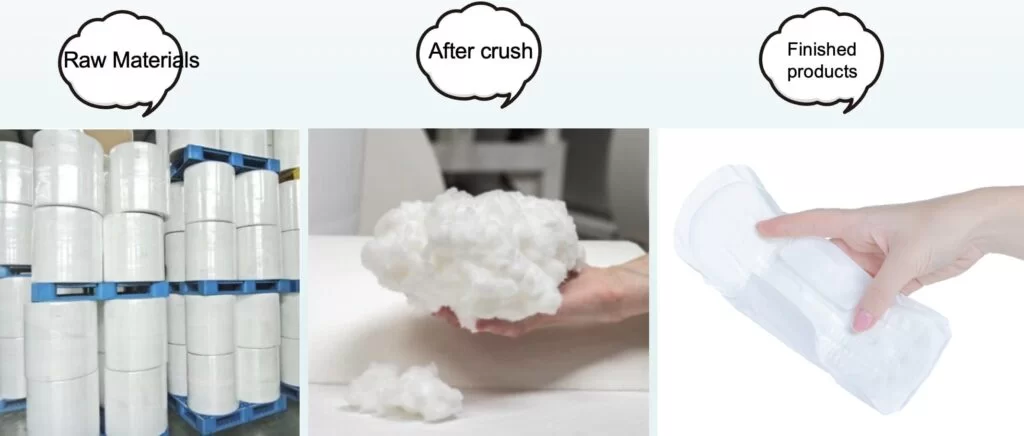There are three main components of a typical sanitary pad: the top sheet, the absorbent core, and the back sheet. The top sheet is the layer that touches your skin, while the absorbent core is the layer that absorbs your menstrual fluid. The back sheet is the layer that helps keep the pad in place and protects your clothes from stains.
Most sanitary napkins also contain a layer of adhesive to help keep the pad in place, as well as a scent to mask any unpleasant odors. Some pads also contain ingredients that can help relieve menstrual cramps.
So, what are the components of a typical sanitary pads? Here’s a quick breakdown:
- Hydrophilic Non-woven (top sheet)
- Core construction (Thick & Thin)
- Super Absorbent Polymer (SAP)
- Cellulose (fluff pulp)
- Release paper
- ADL / Anion chip (functional chip)
- Polyethylene film (PE film)
- Hot Melts
- Packing
Hydrophilic Non-woven (top sheet)
The layer that touches your skin. It can be with different kinds of raw materials with different surfactant treatments used in the process, such as non-woven, cotton, bamboo fiber and so on. There is another typical topshet called perforated mesh film, It’s made from Polyethylene, also a material for topsheet. Its specially dryness and clearness favored by users. But it’s standard a lower grade of topsheet.

Core Construction (Thick & Thin)
The layer that absorbs your menstrual fluid. This is usually made from absorbent materials like cellulose (also called fluff pulp) and SAP (Super Absorbent Polymer). It usually has 2 structures:
A: Tissue paper+Fluff pulp+SAP= Thick Type
A special tissue paper that is different from the regular bathroom tissue and has a higher elasticity and wet strength is another important component of a pad. The tissue essentially serves as a carrier for the pad and helps reduce the pin holes created during the compression. It usually wrapped with fluff pulp mixed SAP as the core, the SAP quantities adjustable that decide the absorbent and price.
B: Airlaid paper+SAP sheet= Ultra Thin Type
Instead of tissue, also can use a Airlaid paper which is mainly made of wood pulp as the carrier (for the absorbent core), it’s a full wrap material around the core and center will be SAP paper for absorbent core which make sanitary pad ultra thin but more absorbent.

Super Absorbent Polymer (SAP)
With its abbreviation SAP, It is typically used in fine granular form (like table salt). This polymer is usually combined with fluff to create the core matrix It helps improve capacity for better retention in a disposable sanitary pad, allowing the product to be thinner with improved performance and less usage of pine fluff pulp.

Cellulose (fluff pulp)
Fluff pulp is an absorbent fiber made from wood pulp. It is used in a wide variety of products, including disposable diapers, sanitary pads, and incontinence products. Fluff pulp helps to absorb liquid and keep the wearer dry. Fluff pulp is found at the center of the core, in a ratio with an SAP (i.e., 50/50 or 30/70). It helps with rapid absorption and distribution of fluid. Fluff pulp also assists with core integrity and improves core matrix stability. Adhesives are used to stabilize the fluff/SAP matrix.

Release Paper
The release paper is the layer that is removed before wearing the pad. It helps keep the pad from sticking to your skin and also protects the adhesive on the back of the pad. It is coated on one side with a release agent, which provides a release effect against the hot-melt.

ADL / Anion chip (functional chip)
ADL (Acquisition Distribution Layer), also called blue chip, made of non-woven, color available in Blue and Green. Anion chip, with the function of releasing negative ions, anti-bacterial, far-infrared emission and odor removal, applicant on a pad that can control odor, some pads also contain ingredients that can help relieve menstrual cramps.

Polyethylene film (PE film)
This is the layer that covers the absorbent core and helps prevent leaks. It is typically made from a thin, plastic-like material called polyethylene. Also can use as wrapping film, keep the pad clean and avoid the pad gets damp.

Hot Melts
They are used to glue the different components of the pad, such as the core construction and the back position adhesive (release paper). Most of the times two types of adhesives are used: A construction adhesive, for the structure like the Nonwovens, tissue, backsheet, and back position adhesive, for the back and wings release paper. The back position adhesive has higher elasticity and bonding strength and it is generally more expensive than construction adhesives.

Packing
The packaging is designed to keep the pad clean and dry until it is ready to be used. It can be customized as per buyer’s logo and preferred design, the most economic is the PE packing; Aluminium foil bag which is resealable but double cost than PE bag; Some countries also likes to use zipper bags; Paper boxes are generally used for environmentally friendly products such as organic cotton and bamboo sanitary napkins. Usually two kinds of outer packing used, export carton or transparent bag, transparent bag more preferred by buyers due to cheaper and able to press to load more, especially in this very high freight time.

So there you have it, the basic components of a typical sanitary pad! As you can see, there is a lot that goes into making these products, absorbent, comfortable, and leakproof.
Thank you for reading! We hope this article was helpful. For more information on menstrual hygiene products, be sure to check out our website.





